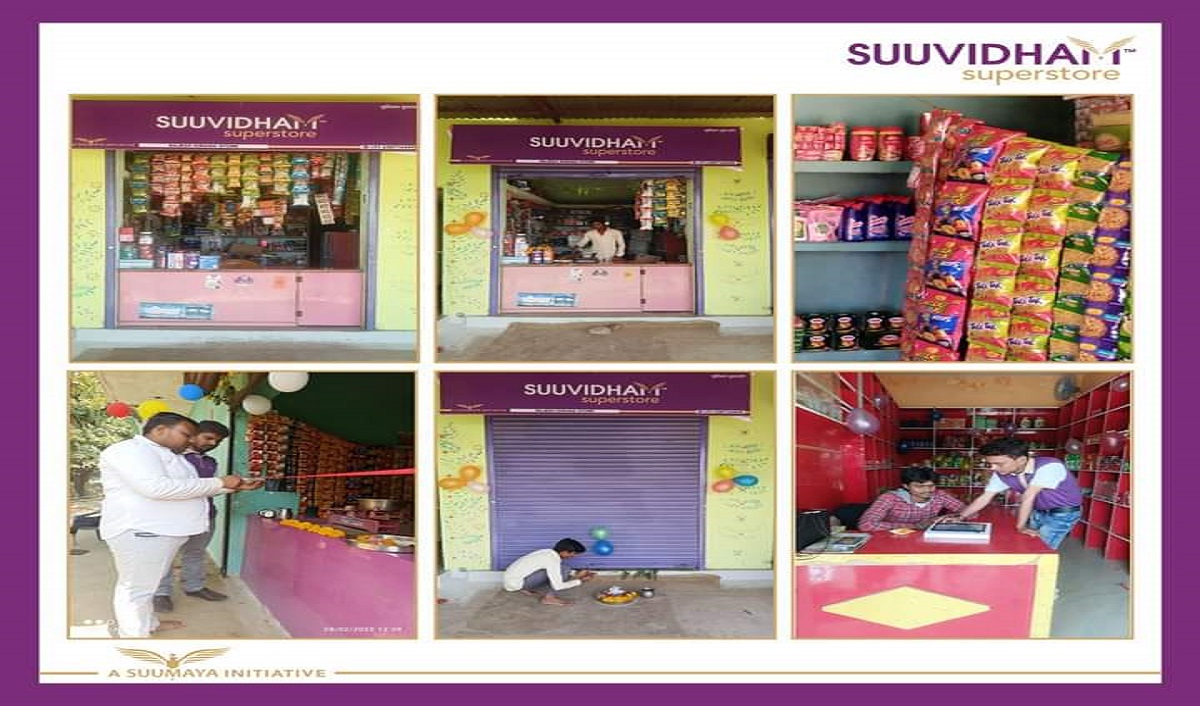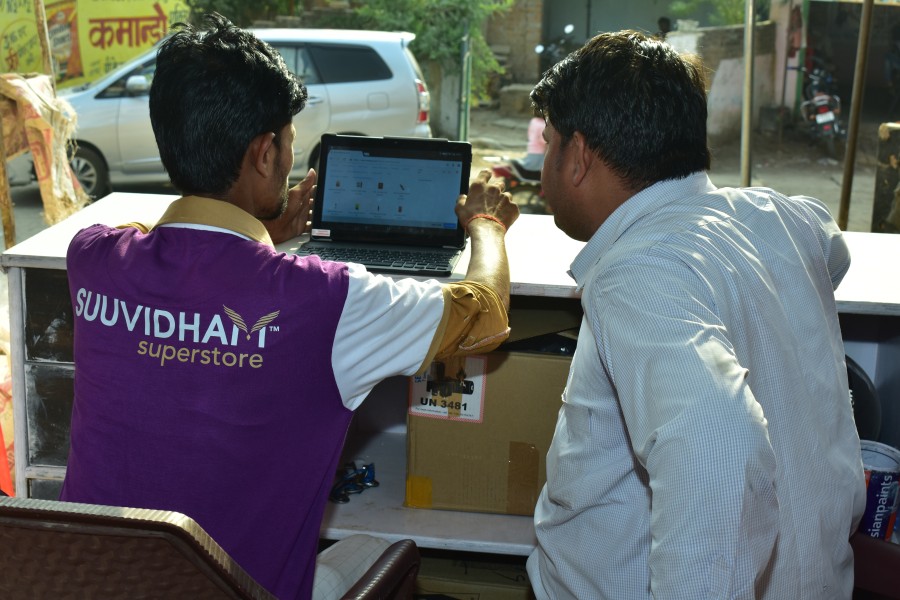

 NSE 524.35 (5.00%)
NSE 524.35 (5.00%)
Unleashing India’s potential, village by village
A part of Suumaya Retail Limited (a wholly-owned subsidiary of Suumaya Indistries Limited), our unique format of retail stores is redefining the concept of kirana stores for rural India and the way the village population procure their day-to-day needs.
As a go-to store for aiding every villager, we provide quality goods at competent rates and value for money. Each store retails consumable items such as food grains and various FMCG products and other consumer products.

The impact of these stores vis-à-vis the rural community of the country has been massive. Some of the positives include:
Under the pilot phase, we established these stores in over 3,000 villages. Our robust expansion plans include covering over four lakh villages across the length and breadth of the country within the short span of a year.

Suuvidham retail chain is based on Company Owned Company Operated (COCO) and Company Owned Franchise Operated (COFO) business concept.
Read More
Suumaya Industries Ltd. (NSE Code: SUULD) is an emerging diversified conglomerate group established in the year 2011. The group is backed by experienced promoters with over three decades of experience in the Textile Industry.
Read More
In the pilot phase, the company plans to open 30 plus “Suuvidham Superstore” retail chain in Uttar Pradesh in the first quarter of 2022.
Read More
Mumbai-based ethnic apparel manufacturer Suumaya Industries has picked up a minority stake in Nysaa Retail Pvt Ltd, which runs the value retailing chain 1-India Family Mart, for about Rs 5 crore, according to two people familiar with the deal.
Read More
India is the largest exporter of rice and its numbers have been on an upward trajectory. But the country’s status is set to face some challenges as the odds are likely to get stacked against it.
Read More
In a world where consumer behavior is rapidly evolving, the importance of an omnichannel approach for fashion brands cannot be overstated. The post-pandemic era has ushered in a new reality for the fashion industry, where brands are now reevaluating their strategies and adopting a hybrid model of operating that encompasses both online and offline channels. It is no longer just a matter of growth, but rather a question of survival.
The pandemic has significantly impacted consumer habits, with a surge in online shopping as people sought convenience and safety. As a result, brands that once solely focused on their offline presence are now embracing the digital realm with aggressive online strategies. On the other hand, e-commerce giants that initially dominated the online space are recognizing the value of brick-and-mortar stores in building stronger connections with customers.
One of the key factors driving the need for an omnichannel approach in the Indian fashion industry is the unique buying behavior of the majority of the target audience. Indian consumers still prefer the traditional “Touch-&-Try” shopping experience, where they can physically interact with the products before making a purchase decision. By having both online and offline channels, fashion brands can cater to the diverse needs of their customers, ensuring that they have a seamless and enriching shopping experience, regardless of their preferred shopping method.
Let’s delve into the advantages of adopting an omnichannel strategy for fashion brands:
1. Enhanced Customer Experience : An omnichannel approach allows brands to provide customers with a consistent and personalized experience across all touchpoints. Whether a customer chooses to shop online, in-store, or even switch between the two, the brand remains cohesive and familiar, enhancing brand loyalty and customer satisfaction.
2. Data-Driven Insights : Integrating online and offline channels enables brands to collect and analyze valuable data about customer behavior, preferences, and purchase patterns. This data can be used to fine-tune marketing strategies, optimize inventory management, and predict trends, ultimately leading to better decision-making.
3. Increased Reach and Visibility : By expanding their presence to both online and offline platforms, fashion brands can reach a broader audience. Online channels enable them to tap into the vast potential of e-commerce and social media, while brick-and-mortar stores can target customers who prefer the physical shopping experience.
4. Flexible Fulfillment Options : With an omnichannel strategy, brands can offer multiple fulfillment options, such as in-store pickup for online orders or home delivery for in-store purchases. This flexibility adds convenience for customers and further boosts their overall shopping experience.
5. Building Brand Trust : Having a strong offline presence can instill trust and credibility among consumers, as physical stores provide a tangible representation of the brand. Additionally, it gives customers the reassurance that they can visit a store for any assistance or after-sales support.
6. Navigating Market Uncertainties : The pandemic highlighted the importance of diversification in business operations. An omnichannel approach helps fashion brands diversify their revenue streams, mitigating the impact of market fluctuations and uncertainties.
As fashion brands navigate the dynamic landscape of consumer preferences and market trends, embracing an omnichannel strategy becomes a crucial step toward staying competitive and relevant. The integration of online and offline channels not only enhances the customer experience but also lays the foundation for sustainable growth and adaptability in an ever-changing industry.
In conclusion, the omnichannel approach is no longer a luxury but a necessity for fashion brands in today’s post-pandemic world. By blending the physical and digital realms, brands can create a seamless shopping experience, build stronger connections with customers, and thrive in an increasingly competitive market. As we look to the future, fashion brands must embrace this hybrid model not just for growth, but for their very survival.

Fast-moving consumer goods (FMCG) have always been the lifeblood of the retail industry, catering to the daily needs of consumers across the country. While urban markets are well-established and fiercely competitive, it is the rural markets that hold immense potential for growth and transformation. FMCG Rural Retail is the backbone of India’s rural economy, driving economic progress, employment generation, and uplifting the standard of living for millions of people. In this blog, we delve into the significance of FMCG rural retail, the challenges it faces, the strategies to harness its true potential, and how SUUVIDHAM, an innovative FMCG Rural Retail venture, is revolutionizing the market with its unique value proposition (USP).
The Significance of FMCG Rural Retail:
Rural India is home to nearly two-thirds of the country’s population and is a crucial market for FMCG companies. With rising disposable incomes, changing lifestyles, and improved infrastructure, rural consumers have become major contributors to the FMCG sector’s growth. Additionally, government initiatives like the Pradhan Mantri Gram Sadak Yojana (PMGSY) and Digital India have bolstered rural connectivity and enabled easier access to products and services.
1. Employment Generation: FMCG rural retail plays a significant role in providing employment opportunities to millions of people. From local kirana (mom-and-pop) stores to organized retail chains, the sector creates direct and indirect jobs, thereby supporting livelihoods and reducing migration to urban areas.
2. Consumer Reach: The penetration of FMCG products in rural areas has increased considerably, indicating a growing demand for brands that cater to the unique needs of rural consumers. From food and beverages to personal care products and home essentials, FMCG rural retail serves as a bridge between manufacturers and consumers in remote locations.
3. Financial Inclusion: As digital payment systems become more prevalent, FMCG rural retail acts as a crucial touchpoint for promoting financial inclusion. Through the adoption of digital payment methods, rural consumers gain access to formal financial services, creating a more inclusive economy.
Despite the immense potential, FMCG rural retail faces several challenges that require thoughtful solutions to unlock its true potential.
1. Infrastructure: Inadequate infrastructure remains a significant obstacle, hindering the seamless distribution of goods to remote areas. Poor road connectivity, unreliable power supply, and limited warehousing facilities often lead to supply chain inefficiencies and higher operational costs.
2. Reach and Awareness: Building awareness and convincing rural consumers to adopt new products can be challenging due to the diversity of languages, cultures, and consumption habits. Effective communication strategies and localized marketing campaigns are essential for bridging this gap.
3. Last-Mile Connectivity: The last mile of product delivery poses considerable logistical challenges. Developing innovative distribution models and leveraging technology for efficient last-mile connectivity is crucial for reaching the farthest corners of rural India.
Strategies for Success:
1. Localized Approach: FMCG companies need to adopt a localized approach by understanding the specific needs, preferences, and purchasing power of rural consumers. Customizing products and marketing strategies can help establish a deeper connection with the target audience.
2. Leveraging Technology: Embracing technology, such as mobile apps for ordering and digital payment systems, can streamline operations and enhance the overall shopping experience. Additionally, data analytics can provide valuable insights into consumer behavior and demand patterns.
3. Strengthening Distribution Networks: Collaborating with local retailers and distributors can strengthen the distribution network and facilitate better access to remote markets. Building strong partnerships can also help overcome trust barriers and establish brand credibility.
4. Educating and Empowering Retailers: Providing training and knowledge-sharing sessions to rural retailers can enhance their understanding of products and marketing techniques. Empowering them with the right tools and information can lead to better customer service and increased sales.
SUUVIDHAM’s Unique USP:
SUUVIDHAM, a pioneering FMCG Rural Retail venture, has revolutionized the rural retail landscape by adding unmatched value to its services.
1. Customized Buying Options: SUUVIDHAM understands the specific needs and preferences of rural consumers. By offering tailored product choices, it ensures every customer finds precisely what they require, fostering strong customer loyalty.
2. Multiple Brands Under One Roof: SUUVIDHAM brings a wide assortment of FMCG brands together in a single store. This convenience allows rural consumers to access various products without having to travel long distances, saving time and effort.
3. Local Brands for Better Margins: SUUVIDHAM takes pride in promoting and supporting local brands. By providing these brands with a platform, they gain access to a larger customer base, increasing their margins and contributing to the growth of the local economy.
4. Credit Facility: Understanding the financial constraints of rural customers, SUUVIDHAM offers a flexible credit facility. This enables consumers to purchase essential goods and repay over time, enhancing their purchasing power and improving their quality of life.
5. Delivery Assistance: SUUVIDHAM goes the extra mile by providing delivery assistance. This ensures that products reach the customers’ doorsteps promptly, even in remote areas, fostering convenience and trust.
6. Use of Technology: SUUVIDHAM embraces technology to optimize its operations and elevate the shopping experience. With mobile apps for ordering and digital payment systems, customers can transact seamlessly and efficiently.
Conclusion:
FMCG rural retail is an instrumental force in driving rural development, economic growth, and social progress in India. By recognizing the unique challenges and opportunities in this market, FMCG companies can harness the vast potential of rural India and create a win-win situation for all stakeholders. With innovative strategies and a customer-centric approach, companies like SUUVIDHAM are leading the way in empowering rural consumers with unmatched retail experiences. As FMCG companies tap into the resilience of rural retail, they contribute not only to their own growth but also to the prosperity of rural India as a whole.

The confectionery market in India has witnessed significant growth and evolving trends in recent years. With a population of over 1.3 billion people and a rising middle class, India presents a lucrative market for confectionery products. Here are some key trends:
The Indian consumer’s tastes and preferences have been evolving rapidly. There is a growing demand for premium and indulgent confectionery products, including chocolates, candies, and sweets with unique flavors and innovative packaging.
While indulgence remains popular, there is also a rising emphasis on healthier options. Consumers are seeking confectionery products made from natural ingredients, reduced sugar content, and free from artificial colors or preservatives. This trend has led to the emergence of organic and natural confectionery brands in the market.
Rapid urbanization in India has played a vital role in the growth of the confectionery market. Urban areas have witnessed increased disposable incomes, changing lifestyles, and exposure to global confectionery brands, leading to higher consumption levels.
The advent of e-commerce platforms has revolutionized the confectionery market in India. Online platforms provide easy accessibility, a wide range of products, and convenience in purchasing confectionery items. This has opened new avenues for small and niche confectionery brands to reach a larger consumer base.
Festivals and occasions play a significant role in Indian culture, where gifting confectionery is a common practice. Seasonal and festival-specific confectionery offerings witness high demand during occasions like Diwali, Eid, and Christmas, driving market growth.
International confectionery giants have recognized the potential of the Indian market and have been expanding their presence. They are introducing new product variants, investing in marketing campaigns, and leveraging distribution networks to capture a larger market share.
These trends indicate a positive growth trajectory for the confectionery market in India, driven by changing consumer preferences, urbanization, e-commerce, cultural practices, and increased focus on health-conscious choices.
Suuvidham is constantly working on value addition and growing in the space of confectionery market. We are exploring opportunities in different markets in India.

The FMCG sector is one of the largest and most important sectors in the Indian economy. It accounts for over 15% of the country’s GDP and employs over 100 million people. The sector is also a major contributor to exports, with confectionery brands being one of the leading export sectors.
The FMCG sector has been growing steadily in recent years, and this trend is expected to continue in the coming years. This growth is being driven by several factors, including rising incomes, urbanization, and changing consumer preferences. Confectionery brands are playing a major role in the growth of the FMCG sector. They are doing this by innovating and launching new products, expanding into new markets, and investing in marketing and advertising. Some of the key trends in the confectionary market include:
• The growing popularity of healthy and natural snacks.
• The Growth of Rural Retail.
• The increasing demand for personalized and customized products.
• The growing popularity of online and social media shopping. Advantages of Rural Markets in the Growth of FMCG Markets:
• Large and growing population: The rural population in India is large and growing. This provides a large potential market for FMCG brands.
• Increasing purchasing power: The purchasing power of rural consumers is increasing. This is due to factors such as rising incomes and government initiatives such as the Pradhan Mantri Jan Dhan Yojana (PMJDY).
• Changing consumption patterns: Rural consumers are increasingly adopting modern consumption patterns. This is due to factors such as exposure to mass media and migration to urban areas.
• Government support: The government is providing support to the FMCG sector in rural areas. This is through initiatives such as the Pradhan Mantri Gramin Awaas Yojana (PMGKAY) and the Pradhan Mantri Kaushal Vikas Yojana (PMKVY).
These advantages make rural markets an attractive proposition for FMCG brands and Confectionery brands that can adapt to these trends and cater to the changing needs of consumers will be well-positioned to succeed in the years to come.
Suuvidham has recently tie-up with Rajasthan-based Biscuit Brand to explore bigger opportunities in Uttar Pradesh. We at Suuvidham are putting constant efforts to match the pace of the FMCG market which is growing steadily.
.
.
.

The biscuit industry in the rural market of India has undergone a remarkable transformation in recent years, riding the wave of increasing disposable income and evolving consumer preferences. This delectable snack has transcended its urban origins to become a beloved staple in the hinterlands, reshaping the rural consumption landscape.
With rural households experiencing rising disposable income, there has been a perceptible shift in spending patterns. Biscuits, once considered a luxury, have seamlessly transitioned into an affordable indulgence for the rural populace. This evolution has been facilitated by a concerted effort from both established conglomerates and nimble local players.
One of the key drivers behind this transformation is an acute understanding of the idiosyncratic needs and tastes of rural consumers. Market players have adeptly navigated the complex tapestry of regional diversity, offering a plethora of region-specific flavors that resonate with local palates. This localized approach has propelled local brands into the spotlight, as they possess an innate ability to decipher and cater to the intricate preferences of rural consumers.
The rural expansion of the biscuit market has been further fortified by an expansive distribution network that traverses even the most geographically remote areas. This logistical marvel ensures that crispy delights find their way to the tiniest of villages, bridging the urban-rural divide in gastronomic satisfaction. It’s not uncommon to witness ubiquitous biscuit stalls nestled amid bucolic landscapes, a testament to the sector’s unparalleled reach.
A pivotal factor underpinning the rural biscuit boom has been the strategic deployment of promotional campaigns. Industry stakeholders have adeptly communicated the nutritional virtues and unparalleled convenience of biscuits as an on-the-go snack. These efforts have engendered a perception shift, positioning biscuits as not only a delectable treat but also a convenient source of sustenance in the fast-paced rural milieu.
The rural biscuit market in India finds itself at the crossroads of immense opportunities for sustained growth and deep market penetration. The confluence of rising rural income, an empathetic understanding of local preferences, expansive distribution networks, and persuasive marketing strategies has set the stage for a prolonged upward trajectory. As the industry continues to innovate and adapt, rural consumers can look forward to an ever-expanding array of biscuit offerings that cater to their evolving tastes while enriching the tapestry of India’s rural consumption narrative.